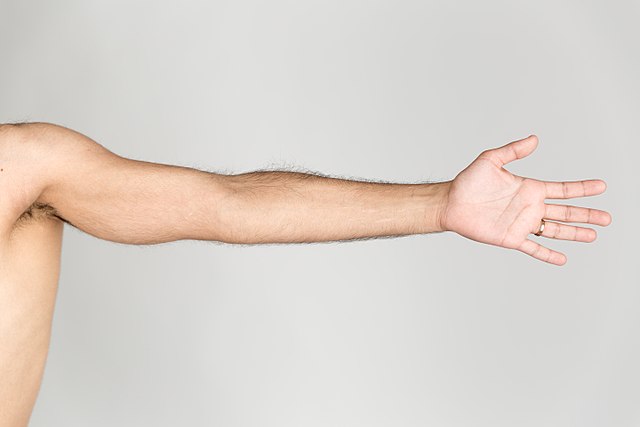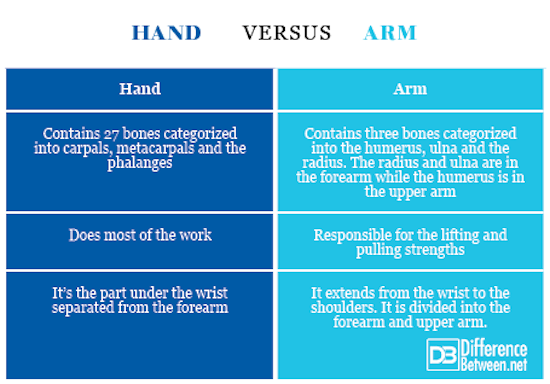Difference Between Hand and Arm
Hand and arm are two parts of certain animals including human that are often not well understood. Others regard the part from fingers to the elbow as the hand while from the elbow to the shoulders as the arm. That is a misunderstanding this article seeks to clarify. These two parts also differ in the composition of bones and muscles, a field that is too technical but a glimpse is given here-under.
What is an arm?
With reference to human anatomy, an arm is divided into the upper and fore arm. The upper arm is extending from the shoulders to the elbow, and it is the part that is predominantly responsible for lifting and pulling strength. The fore arm part extends from the elbow to the wrist, a part that divides the forearm (or generally the arm) and the hand. The muscles found in the forearm are responsible for the rotation of the hand because they also rotate and flex. The elbow is a hinged joint that separates the forearm from the upper arm, and it also allows the arm to open up to an angle of 180 degrees.
The arm is composed of three long bones called the humerus, radius and the ulna. The humerus is joined by the elbow to the ulna and radius bones. It is a tough bone and is hardly broken unless under intensive forces because it can withstand loads up to 300 pounds. Considering the muscles in the arm, the arm is divided by the lateral and medial intermuscular septa that separate the muscles into the posterior and anterior parts of the arm. Both the medial and lateral intermuscular septa are termed the fascial layer. The anterior and posterior compartments of the arm have muscles that perform the same function. The other muscles in the arm include the brachioradialis which is response for the rotation of the hand for the palm to face forward, and the deltoid muscle that extends over the shoulder.
What is a hand?
As aforementioned, the hand is the part below the wrist that does most of the work. It can rotate or flex to any direction due to the structural composition of bones in it. The hand basically has four fingers and a thumb. See the picture below of the hand and the arm:
Many animals such as monkeys, baboons, chimpanzees, and lemurs also have hands but the main emphasis is put on the human anatomy. The basic definition of a hand is to have two-opposing thumbs on each hand. That is the case with human hands, they also have fingerprints.
A human hand has 27 bones. Fourteen of these bones are the phalanges as shown in the picture above. The four fingers have equal number of these bones while the thumb is short of one. The fingers are connected to the carpal bones of the wrist by metacarpal bones. There is a total of 5 metacarpals and 8 carpal bones in human hands.
The hand has vast functions in human beings other than doing the work. Others are using it to communicate in sign language or body language. The word “hand” is also used in many contexts of language apart from referring to the physical part of the body. For example, “to lend a hand” means to help someone. “Hand me that copy” means give me that copy. In other instances both the arm and hand are used simultaneously for a different meaning.
Key differences between a hand and an arm
Definition of a hand and an arm
A hand is the part below the wrist with four fingers and a thumb in human anatomy. It is separated by the wrist from the forearm. An arm is the part that extends from the wrist to the shoulders. It is divided into the forearm and the upper arm separated by the elbow.
Bone composition for a hand and an arm
The arm basically has three main bones, the ulna, radius and the humerus. The humerus is the main bone in the upper arm connected by the elbow joint to the radius and ulna. This humerus bone is the strong and it seldom breaks unless put under massive pressure. When the amputation is done, the entire arm is often removed in medical treatments.
The hand, on the other hand, has a number of bone structures. In total, there are 27 bones in a human hand categorized into phalanges, metacarpals and the carpals of the wrist. The metacarpals connect the finger’s phalanges to the carpals. The picture above illustrates this.
Work done by a hand and an arm
The hand does most of the work by rotating and flexing. Human hands are the most effective among all animals. The hands are also used in communication in the deaf community. The arm is basically for lifting and pulling functions.
Comparison table for a hand Vs. an arm
Summary of a hand Vs. an arm
- A hand is a part below the wrist that has four fingers and a thumb
- An arm is divided into a forearm and an upper arm. The upper arm extends from the elbow to the shoulders while the forearm extends from the wrist to the elbow
- The arm is responsible for most of the lifting and pulling strengths while the hand does most of the work, and is also used in body and sign language
- The hand has 27 bones divided into carpals, metacarpals and the phalanges
- The arm has three bones categorized into the radius, ulna and the humerus
- Difference Between CBD and Indica - April 22, 2019
- Difference Between Unilateral Contract and Bilateral Contract - February 8, 2019
- Difference Between Polki and Kundan - December 15, 2018
Search DifferenceBetween.net :
Leave a Response
References :
[0]Paul Pitts, Uwe Kaulbars, Hans Lindell, Snævar Leó Grétarsson, Michael Machens, Anthony J. Brammer, Gongqiang Yu, Thomas Schenk, Fabian Haas, (01 Sep 2017). Hand-arm vibration: Exposures to isolated and repeated shock vibrations: Review of the International Expert Workshop 2015 in Beijing. DGUV/IFA
[1]Healthline Medical Team (October 6, 2014). Human Body Maps. Accessed at https://www.healthline.com/human-body-maps/arm. Accessed on 16 June 2018.
[2]Image credit: https://upload.wikimedia.org/wikipedia/commons/thumb/6/6d/Extended_arm.jpg/640px-Extended_arm.jpg
[3]Image credit: https://upload.wikimedia.org/wikipedia/commons/thumb/3/32/Human-Hands-Front-Back.jpg/640px-Human-Hands-Front-Back.jpg




